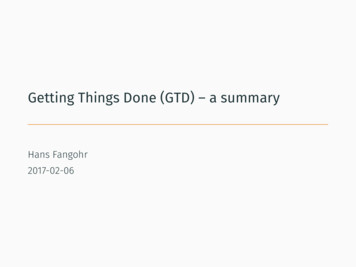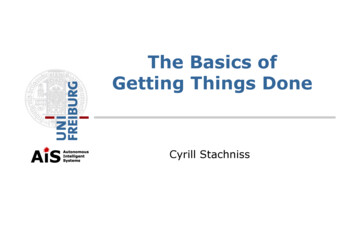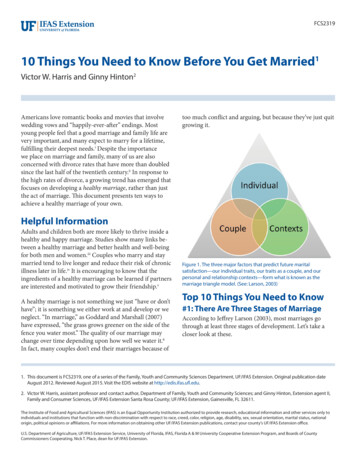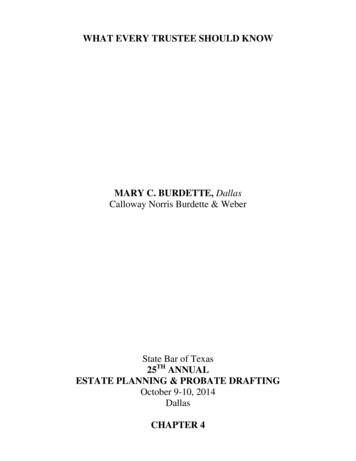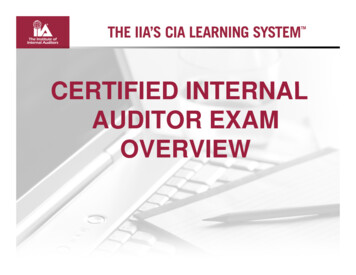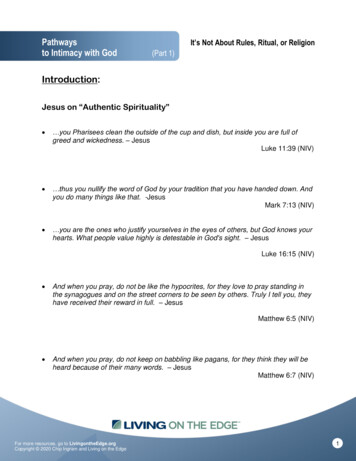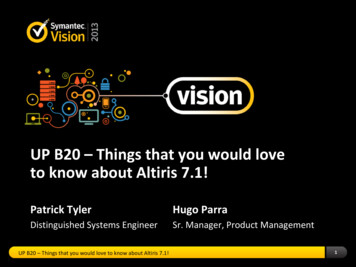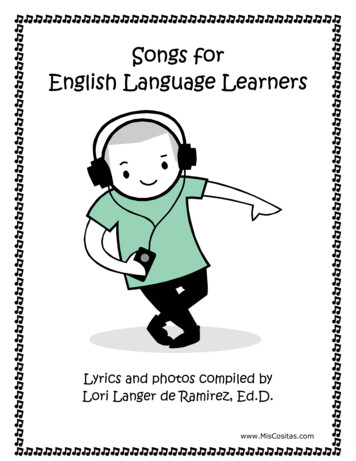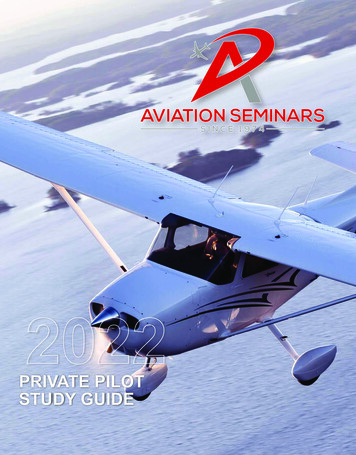
Transcription
PRIVATE PILOTSTUDY GUIDE
IMPORTANT INFORMATION FOR SEMINAR PREPARATIONPLEASE READ THIS CAREFULLY!People attending our courses come to class with wide variations of bothknowledge and experience – from those who are still waiting to take their firstflight lesson, through those who have been ready for their flight tests for years(private or commercial), but haven’t yet completed their FAA knowledge exam.However, our recommendations below are applicable for everyone.The first thing you will discover is that our course manual is intentionally small.Many test preparation guides have 4 or 5 times as many pages, trying to covermuch more information than necessary for the FAA Knowledge Exam. Webelieve that it is important to obtain all of the knowledge about flying that you can.We do not produce this book with the belief that it will contain all the informationyou need to know as a pilot, but instead wish to provide you with a study guidethat is concise and specific to your FAA Exam. We have written the summariesto be as brief as possible while still providing the necessary background toexplain the topic and questions. You’ll find that we cover a lot more informationand detail in the classroom!Here’s the most effective way to preview this material:First, you will notice that we have bolded and italicized the correct answer toeach of the FAA test questions in the book. We’ve learned that it iscounterproductive to test yourself by reading a question and its selection ofanswers without first knowing the correct answer.Second, read through each of the summaries. Directly following each summary,read each question followed by the associated correct answer. Don’t bother toread the incorrect answers, and don’t worry about slowing down to analyze andstudy at this time – we simply want you to become familiar with the type ofinformation the FAA wants you to learn, and become exposed to the questionsand correct answers. This will help you focus more productively in class, and willhelp prepare you for additional learning and study. IF YOU DO NOTHING ELSE,AT LEAST READ THROUGH THE BOOK THE DAY BEFORE THE TEST ASDESCRIBED ABOVE. Most people find that this can be done in about 2 hours.Finally, make sure to take the Aviation Seminars Online Practice Exams after theclass. Prior to taking the FAA exam, you should be scoring in the mid-80’s onthe practice exams.THANK YOU FOR CHOOSING AVIATION SEMINARS FOR YOUR TESTPREPARATION!
COURSE SUMMARYThings You Should Know About the FAA Exam Pages 01Federal Aviation Regulations/Human Factors 03-24Aerodynamics and Aircraft Operations .25-34Navigation . 35-39Aircraft Instruments .40-45Aeronautical Information Manual . .46-55Aircraft Performance 56-60Weight and Balance .61-63Weather Theory 64-69Weather Reports and Forecasts 70-75Copyright 20 2 Aviation SeminarsAviation SeminarsEl Cajon, CA 92020800-257-9444
Things You Should KnowAviation SeminarsTHINGS YOU SHOULD KNOW ABOUT YOUR FAA COMPUTER EXAMTo get the best results on your exam:As time allows, answer all the questions inthe Course Summary BEFORE coming toclass, so the instructor can clarify any withwhich you have trouble. Allow some timeSaturday evening for a second review ofthose questions you missed.Take some notes as you listen to the lecture,but also keep an eye on the visuals theinstructor uses in the presentation.Complete all your available on-line practicetests.Bring with you to the test: Take the exam within 3 days after theseminar.About computer testing:AVIATION SEMINARS constantly monitorsfor new areas that the FAA is asking of itscurrent pilot applicants in the knowledgetests.FAA airman knowledge testing is done bycomputer only. Two private companies areauthorized by the FAA to administercomputer tests. A complete list of thosecompanies and their testing sites is availablethrough the FAA’s website.Each FAA-approved computer testingcompany sets its own fees and maintains anation-wide, toll-free registration/informationtelephone number.There are no minimum flight timerequirements to take the Private Pilotknowledge exam. However the applicantmust be at least 15 years old at the timethey take the written test.The Private Pilot exam has 60 questions,which are chosen from over 600 in the examdatabase. You are allowed 2.5 hours tocomplete the exam.A minimum score of 70% is required to passthe exam. Any failed test report, signed by acertified instructor.Government identification whichincludes current photograph, yoursignature, residential street address,and proof of age. Non-US citizensshould bring passport or immigrationgreen card.Evidence of completion of groundschool and instructor sign-off. Youwill receive this at the end of ourseminar.Flight computer and Plotter. Weprefer a manual E6-B for moreaccurate wind solutions. Directionsprinted on the computer are allowedduring the exam.Electronic calculator, if desired. Youmay be asked to clear the memory.How to take the test:Computer tests are designed to be easy tounderstand and user-friendly, requiring noprevious computer experience.When you arrive at the test center, the testproctor will review your registrationinformation and exam sign-off, and confirmthe correct test.Look through and identify the contents of the“Computerized Testing Supplement” bookwhich your proctor gives you. The mostcurrent version in use is FAA-CT-8080-2H.When you are fully confident of howcomputer testing works, the allotted time foryour test will begin.Testing software allows you to reviewquestions already answered (and changeanswers if needed), or to skip over a difficultquestion and return to answer it later.Testing software keeps you advised of timeremaining for your test. Use your full time todouble-check your answers. Drop us a lineon how you did in our CONTACT US portalin our website!Pg. 1
Pg. 2
RegulationsAviation SeminarsFEDERAL AVIATION REGULATIONSPART 61 - CERTIFICATION OF PILOTSAIRCRAFT CLASSIFICATIONCertificates RequiredWith respect to certification of AIRMEN:A pilot certificate and an appropriate currentmedical certificate or BasicMed must be onyour person when you act as pilot incommand or as a required crew-member. Ifrequested, you must show your certificate toany federal, state, or local law enforcementofficer. (FAR 61.3)CATEGORY - a broad classification of aircraft(airplane, glider, rotorcraft, lighter-than-air).Medical Certificates (Class)To act as a private pilot, you must possess atleast a 3rd Class Medical Certificate or be onBasicMed. If any medical certificate (1st, 2nd,3rd) is obtained before the age of 40, it is validas a 3rd class for 60 months.CLASS - airplane class ratings include singleengine land, multiengine land, single enginesea, multi-engine sea.If any medical certificate (1st, 2nd, 3rd) isobtained after the age of 40, it is valid as a 3rdclass for only 24 months. (FAR 61.23)Medical Certificates (BasicMed)BasicMed allows a pilot who has previouslyheld a valid “class” medical certificate on orafter July 15, 2006, to act as PIC with 3rdclass privileges. (Not for hire)TYPE - a specific make and model of aircraft,such as Cessna 150 or Piper Seneca, etc.Requirements for BasicMed- Must hold a valid state driver’s license.- Must get a basic physical from a licensedphysician, then again every 4 years (48 mo)- Must take the on-line Medical EducationCourse (MEC) then again every 2 years (24mos)Limitations while flying under BasicMed- Flight in U.S, Bahamas and Mexico only.- Maximum altitude 18,000 feet MSL.- Maximum speed 250 KIAS.- Maximum occupants 6 (including pilot).- Maximum aircraft weight 6,000 MTOW.A pilot must hold a type rating to act as pilot incommand of an aircraft having a gross weight ofmore than 12,500 pounds or any pure jet. (FAR61.5)With respect to certification of AIRCRAFT.The term “category” refers to normal, utility, andacrobatic aircraft. (How aircraft is loaded)“Class” refers to airplane, helicopter, glider orhot air balloon. (FAR 1.1)Pg. 3
RegulationsAviation SeminarsRecent Flight ExperiencePART 91 - GENERAL OPERATING RULESTo act as pilot in command, you must havepassed a Flight Review within the last 24calendar months. (FAR 61.56)Responsibility of PilotPilot QualificationsTraining and a logbook endorsement from anauthorized flight instructor are required to actas pilot in command of a high performance orcomplex airplane.High performance an engine with more than200 HP.Complex retractable gear flaps controllable pitch propeller (FADEC Included)To carry passengers during the day, you needto have made 3 takeoffs and 3 landings withinthe last 90 days in an aircraft of the samecategory and class, and type, if a type ratingis required. Takeoffs and landings in a tailwheel airplane must be to a full stop.To carry passengers at night, you need toalso have made 3 takeoffs and landings to afull stop at night (one hour after sunset to onehour before sunrise) within the last 90 days inan aircraft of the same category and class.If you have not met these requirements andare carrying passengers, then you must landbefore one hour after sunset. Example: Ifsunset is 1830, the latest time passengersmay be carried is 1929. (FAR 61.57)Change of AddressIf you change your permanent address, youmust notify the FAA Airmen CertificationBranch within 30 days. (FAR 61.60)Private Pilot PrivilegesA private pilot may share operating expensesof a flight with the passengers, and act aspilot in command carrying passengers whopay for the flight, if a donation is made to acharitable organization for the flight. (FAR61.118)Pg. 4The pilot in command is the final authority as tothe operation of an aircraft, and determines if anaircraft is in condition for safe flight.In an in flight emergency, you may deviate fromany FAR or any ATC clearance to the extentrequired to meet that emergency. If you deviatefrom a regulation, you must send a report ofthat deviation upon request. (FAR 91.3)If you are given landing priority by ATC afterdeclaring an emergency, you are required, ifrequested by ATC, to submit a detailed report ofthe emergency to the chief of the ATC facilitywithin 48 hours. (FAR 91.123)Preflight ActionAs pilot in command (for every flight), you mustbecome familiar with all available informationconcerning that flight, and determine runwaylengths at airports of intended use and theaircraft’s takeoff and landing distance data.For flights not in the vicinity of an airport, youmust also be familiar with weather, fuelrequired, and an alternative course of action ifthe flight cannot be completed as planned.(FAR 91.103)Aircraft Certificates Required OnboardOPERATING LIMITATIONS - either a currentFAA-approved flight manual, approved manualmaterial, markings or placards, or anycombination stating each operating limitation.(Experimental and Special Light Sport Aircraftlimitations are attached to the AirworthinessCertificate)AIRWORTHINESS CERTIFICATE - remainsvalid as long as the aircraft is maintained andoperated as required by FAR’s and has aReturn-to-Service statement after maintenance.REGISTRATION CERTIFICATE – is valid for aperiod of 3 years.
RegulationsAviation SeminarsAlcohol And DrugsRight of Way RulesYou may not act as pilot within 8 hours afterthe consumption of alcohol, or while havingmore than .04 percent of alcohol in the blood.An aircraft in distress have the right of way overall other aircraft.It takes about 3 hours to rid your body of thealcohol from just one beer.A person under the influence of alcohol ordrugs may not be carried aboard unless in anemergency or if the person is a medicalpatient under proper care. (FAR 91.17)Must report arrest or conviction for drivingwhile intoxicated by alcohol or drugs to theFAA, Civil Aviation Security Division within 60days.Dropping ObjectsObjects may be dropped from an aircraft ifprecautions are taken to avoid injury/damageto persons/property on the surface. (FAR91.15)Use of SeatbeltsPilots are required to conduct a safety briefingto passengers before each flight.All manned aircraft have right away over allunmanned aircraft (including drones).APPROACHING HEAD ON- each alters courseto the right; regardless of category (EvenGliders).CONVERGING- An aircraft towing’ another hasright of way over all other powered aircraft. Aglider has right of way over all powered aircraft.An airship has right of way over an airplane.Otherwise, the aircraft on the right has the rightof way. The other aircraft must give way. Thisalso applies to a seaplane and motorboat.OVERTAKING- the faster alters course to theright and passes well clear.LANDING- the aircraft landing has right of wayover all aircraft on the surface. When twoaircraft are landing, the lower has the right ofway, but it cannot take advantage of that rule tocut in front of the other. (FAR 91.113)Required flight crew-members must keepshoulder harnesses fastened during takeoffand landing, and must keep seatbeltsfastened during takeoff and landing and enroute.Operation Near Other AircraftThe pilot in command must brief passengerson the use of seatbelts and notify them tofasten. their seatbelts during taxi, takeoff andlanding. (FAR 91.107)Restricted/Experimental Aircraft aircraft areprohibited from operating over denselypopulated areas or along congested airways.(FAR 91.313 and 91.319)Supplemental OxygenAircraft Speed LimitsAbove 12,500 MSL up to 14,000 MSL, flightcrew must use oxygen during that flight timein excess of 30 minutes at those altitudes.250 knots below 10,000 MSL.Above 14,000 MSL, the flight crew (Pilot)must use it continuously.Above 15,000 MSL, each occupant must beprovided with oxygen. (FAR 91.211)Formation flight is not allowed except by priorarrangement with the pilot in command of eachflight. (FAR 91.111)200 knots beneath lateral limits of Class Bairspace and in VFR corridor through Class Bairspace. (FAR 91 .117)200 knots within 4nm of the primary airport ofClass C and Class D. (AIM 3-2-4)Pg. 5
RegulationsAviation SeminarsAcrobatic FlightMinimum Safe AltitudesAcrobatic flight is prohibited when:- over any congested area of a city, town orsettlement;-below 1500 AGL;- visibility is less than 3 miles. (FAR 91 .303)Anywhere - an altitude allowing, if a power unitfails, an emergency landing without unduehazard to persons or property on the surface.Parachutes must be worn by the pilot and allpassengers during any intentional maneuverexceeding 60 degrees bank or 30 degreespitch up or down.Over a congested area - 1000 feet above thehighest obstacle within a horizontal radius of2000 feet.Over other than a congested area - 500 feetfrom any person or property. (FAR 91.119)A chair-type parachute must have beenpacked by certified parachute rigger within thepreceding 180 days. (FAR 91.307)Navigation LightsThe definition of nighttime is the time betweenthe end of evening civil twilight and the beginningof morning civil twilight.However, Navigation lights must be turned on fromsunset to sunrise. The right wingtip light is green,the left wingtip is red, the taillight is white, and therotating beacon is flashing red.Determine which way an airplane is flying ifyou can only see one or two navigation lights.(FAR 91.209)CLASS A : Airspace at and above 18,000 MSL.VFR flights are prohibited.CLASS B: Airspace surrounding large majorairports. About 10,000 feet high. Altitude andgeographic limits are shown on sectional chartsby blue solid lines.To fly in Class B airspace requires:Fuel RequirementsYou must have enough planned fuel to fly tothe first point of intended landing, and then flyafter that for 30 minutes at normal cruisingspeed in the daytime, and 45 minutes atnight. (FAR 91.151)ATC Light Signals-two-way communication with ATC;-a transponder with altitude encoding (Mode C)capability when below 10,000 MSL and within30 NM of the primary airport;-Private Pilot Certificate, or Student PilotCertificate with appropriate logbookendorsement. (FAR 91.131)CLASS C: Airspace surrounding regional typeairports. Altitude and geographic limits areshown on sectional charts by magenta solidlines.Class C airspace consists of a 5 NM radiusinner circle from the surface to 4000 AGL, andan outer circle extending from 5 to 10 NM, andfrom 1200 AGL to 4000 AGL. An outer areacalled the Outer Procedural Radius exists out to20 NM.To fly within Class C airspace requires: two-way communication with ATC. a transponder with altitude encoding(Mode C) capability.Pg. 6
RegulationsAviation SeminarsCLASS D: Airspace at other smaller airportsother than B or C that have an operatingcontrol tower. Two-way communications arerequired Shown on a sectional chart as blueairport icon and segmented circle.The lateral dimensions of Class D airspaceare individually tailored and when instrumentprocedures are published, the airspace willnormally be designed to contain theprocedures (i.e. Keyhole)When the control tower is not in operation,this airspace becomes an untowered Class Eairport.While on the ground at the primary airport, aclearance to ‘taxi to’ a runway means you aregiven permission to taxi via taxiways to therunway, but not to cross any intersectingrunways on the way to the runway that youare cleared to.Further clearance is required to cross allrunways. You must also hold short of taxiingonto the active runway that you are taxiing to.After landing at a tower-controlled airport,contact ground control when instructed to doso.Additionally, VFR traffic must receive a SpecialVFR clearance to operate in airspace when theweather is below basic VFR minimums. (FAR91.157)An ATC clearance provides authorization toproceed under specified traffic conditions incontrolled airspace.Federal airways are pre-established routes incontrolled airspace that VFR and IFR traffic mayuse. Federal airways extend from 1200 AGL upto 18,000 MSL, and extend 4 NM either side ofcenterline (8 NM width)Transition AreaA Transition Area (Magenta) is an area ofcontrolled airspace over an airport used to helpprotect IFR traffic by forcing VFR traffic to befurther from the clouds and have at least 3miles of flight visibility.These increased distance from clouds andvisibility for VFR traffic is necessary for both IFRand VFR traffic to see each other when the IFRtraffic emerges from the clouds.Transition Area’s can start at either the surface(B) or 700 feet AGL (A).CLASS E: Any controlled airspace notdesignated as Class A, B, C, or D isconsidered Class E. It extends up to, but notincluding 18,000 MSL.The base of Class E airspace is shown by:-magenta dashed lines indicate controlledairspace that starts at the surface, calledClass E Surface Area;-magenta shaded area indicate controlledairspace starts at 700’ feet AGL.Controlled Airspace (Class E)Controlled airspace (Class E) is where IFRtraffic mainly operates and is given clearanceto fly through the clouds at specific routes andaltitudes, and given separation from other IFRtraffic by ATC.VFR traffic must maintain minimum visibilityand cloud clearance requirements to see andavoid IFR and other VFR traffic when flying incontrolled airspace. (FAR 91.155)A Controlled Airspace begins at 700 feet AGL.B Controlled Airspace begins at surface.(Inside dotted line Class E Surface Area)Pg. 7
RegulationsAviation SeminarsCLASS G AIRSPACE: Any airspace that isnot controlled airspace. Usually not higherthan 1,200 feet AGL, but can extend upwardto 14,500 Feet MSL in mountainous areasWeather Minimums for VFR TrafficSpecial VFR (SVFR)Special VFR can be used to depart a Class Dairport when the reported weather is below1,000 foot ceiling and/or less than 3 SMvisibility, but at least 1 mile.Pilot must request a SVFR from ATC. OnlyATC can issue a SVFR departure / arrivalclearance. Pilot must be able to bereasonably certain they can remain clear ofclouds with at least 1 mile flight visibility.Special VFR at night is not allowed unlesspilot is instrument rated and your airplane isinstrument equipped. (FAR 91 .157)This night rule is for safety reasons. At night,pilots have an increased risk of inadvertentlyflying into a cloud and losing groundreference. IFR pilots would better be able tohandle this situation than a VFR pilot whohasn’t been adequately trained to fly oninstruments.VFR Cruising AltitudesWhenever above 3000 AGL, if your magneticcourse is 0 to 179 degrees, fly odd thousandsplus 500 feet (3500 MSL, 5500 MSL etc). iiyour magnetic course is 180 to 359 degrees,fly even thousands plus 500 feet. Remember that the airway direction ismagnetic course. (FAR91.159)Aircraft Maintenance — GeneralThe owner or operator of an aircraft isresponsible to maintain the aircraft in anairworthy condition. (FAR 91.403)A private or commercial pilot may performsimple preventive maintenance. Preventivemaintenance is allowed by 14 CFR 43.7.The signature, certificate number, and kind ofcertificate held by the person and a descriptionof the work done must be entered in the aircraftmaintenance record. (14 CFR Part 91.407)Carrying Passengers After AlterationOnly a Private Pilot or higher can test fly anaircraft after a major repair or alteration beforepassengers can be carried. (FAR 91.407)Aircraft InspectionsReview maintenance records and perform apreflight inspection to determine airworthiness.The aircraft maintenance records (logbooks)contain the date of the last annual and 100 hourinspection, and the return to service statementshowing the aircraft is legal to fly.All aircraft need annual inspections every 12calendar months. If last annual was performedon July 12, this year, the next annual inspectionwill be due no later than July 31, next year.The transponder must be inspected every 24calendar months. (14 CFR Part 91.413)Pg. 8
RegulationsAviation SeminarsAIRWORTHINESS DIRECTIVES (AD’s)Airworthiness Directives are issued on aircraftby serial number for maintenance typeproblems or parts that are required to beinspected, repaired or replaced. Virtuallyevery aircraft will have had an AD atsometime in the aircraft’s history.Compliance with an Airworthiness Directive ismandatory and must be shown in the aircraftmaintenance records.A pilot may fly an airplane that is not incompliance with an AD only if the AD allows it.Commercial Use MaintenanceFor hire and rental aircraft also used for flightinstruction requires annual and 100-hourinspections. 100 hour inspections are basedon the aircraft tachometer reading.The 100-hour limitation may be exceeded bynot more than 10 hours if necessary to reacha place at which the inspection can be done.If 100-hour is due at 3302.5 hours, but wasactually done at 3309.5 hours, the next 100hour Is due at 3402.5 hours. (FAR 91 .409)PART 830 - NATIONAL TRANSPORTATIONSAFETY BOARD RULINGThe operator of an aircraft must immediatelynotify the NTSB when an accident occurs orany of the following incidents: Inability of required crewmember toperform duties as a result of injury orillness. In-flight fire. Flight control system malfunction orfailure. Overdue aircraft is believed to havebeen involved in an accident. Serious injury that requireshospitalization within 7 days for atleast 48 hours.The operator is required to file a detailedaccident report within 10 days, and an incidentreport when requested.Wreckage may be moved prior to the time theNTSB takes custody, to protect the wreckagefrom further damage. (NTSB 830)ADVISORY CIRCULARS (AC’s)FAA advisory circulars are issued to informthe aviation public of non-regulatory materialof interest. They are available by orderingthose desired from the Government PrintingOffice or on-line at FAA.gov.Those relating to Airmen are covered insubject numbers 60, Airspace in subjectnumbers 70, and General Operating Rules insubject numbers 90.Pg. 9
RegulationsAviation SeminarsTEST QUESTIONS (Use Test Supplement 8080-2H)NOTE: CORRECT ANSWER IN BOLD ITALICS3001.With respect to the certification of airmen, which is acategory of aircraft?A) Gyroplane, helicopter, airship, free balloon.B) Airplane, rotorcraft, glider, lighter-than-air.C) Single-engine land and sea, multiengine land andsea.3002.With respect to the certification of airmen, which is aclass of aircraft?A) Airplane, rotorcraft, glider, lighter-than-air.B) Single-engine land and sea, multiengine land andsea.C) Lighter-than-air, airship, hot air balloon, gasballoon.3003.With respect to the certification of aircraft, which is acategory of aircraft?A) Normal, utility, acrobatic.B) Airplane, rotorcraft, glider.C) Landplane, seaplane.3004.With respect to the certification of aircraft, which is aclass of aircraft?A) Airplane, rotorcraft, glider, balloon.B) Normal, utility, acrobatic, limited.C) Transport, restricted, provisional.3005.The definition of nighttime isA) sunset to sunrise.B) 1 hour after sunset to 1 hour before sunrise.C) the time between the end of evening civil twilightand the beginning of morning civil twilight.3013. AVSEMWhat regulation allows a private or commercial pilot toperform preventive maintenance?A) 14 CFR Part 91.403B) 14 CFR Part 43.7C) 14 CFR Part 61.1133014. AVSEMWhich operation would be described as preventivemaintenance?A) Replenishing hydraulic fluid and servicing landinggear wheel bearings.B) Alteration of main seat support brackets.C) Engine adjustments to allow automotive gas to beused.Pg. 103016.What document(s) must be in your personalpossession or readily accessible in the aircraft whileoperating as pilot in command of an aircraft?A) Certificates showing accomplishment of a checkoutin the aircraft and a current biennial flight review.B) A pilot certificate with an endorsement showingaccomplishment of an annual flight review and a pilotlogbook showing recency of experience.C) An appropriate pilot certificate and an appropriatecurrent medical certificate if required.3017.When must a current pilot certificate be in the pilot’spersonal possession?A) When acting as a crew chief during launch andrecovery.B) Only when passengers are carried.C) Anytime when acting as pilot in command or as arequired crew-member.3018.A pilot acting as pilot in command, or in any othercapacity as a required pilot flight crewmember, musthave in their personal possession or readily accessiblein the aircraft a currentA) logbook endorsement to show that a flight reviewhas been satisfactorily accomplished.B) medical certificate if required and an appropriatepilot certificate.C) endorsement on the pilot certificate to show that aflight review has been satisfactorily accomplished.3019.Each person who holds a pilot certificate or a medicalcertificate shall present it for inspection upon therequest of the Administrator, the NationalTransportation Safety Board, or anyA) authorized representative of the Department ofTransportation.B) person in a position of authority.C) federal, state, or local law enforcement officer.3020.A Third-Class Medical Certificate is issued to a 36year-old pilot on August 10, this year. To exercise theprivileges of a Private Pilot Certificate, the medicalcertificate will be valid until midnight onA) August 10, 2 years later.B) August 31, 5 years later.C) August 31, 2 years later.3021.A Third-Class Medical Certificate is issued to a 51-yearold pilot on May 3, this year. To exercise the privilegesof a Private Pilot Certificate, the medical certificate willbe valid until midnight onA) May 3, 1 year later.B) May 31, 1 year later.C) May 31, 2 years later.
RegulationsAviation Seminars3022.For private pilot operations, a Second-Class MedicalCertificate issued to a 42-year old pilot on July 15, thisyear, will expire at midnight onA) July 15, 2 years later.B) July 31, 1 year later.C) July 31, 2 years later.3023.For private pilot operations, a First-Class MedicalCertificate issued to a 23-year old pilot on October 21,this year, will expire at midnight onA) October 21, 2 years laterB) October 31, next year.C) October 31, 5 years later.3023-1To operate under BasicMed the pilot-in-commandmust have completed a physical examination by astate-licensed physician within the precedingA) 48 monthsB) 24 monthsC) 1 year3023-2For private pilot operations under BasicMed, the pilotin-command is allowed to fly with no more thanA) 6 passengersB) 5 passengersC) 5 occupants3023-3To maintain BasicMed privileges you are required tocomplete the medical examination checklist (MEC)everyA) 48 monthsB) 24 monthsC) 1 year3023 - AVSEMWhat is the maximum altitude a private pilot operatingunder BasicMed can fly?A) 10,000 feetB) 18,000 feetC) 1,200 feet3023 - AVSEMFor private pilot operations under BasicMed, the pilotin-command is allowed to fly with no more thanA) 6 occupantsB) 5 occupantsC) 6 passengers3023 - AVSEMFor private pilot operations under BasicMed, the pilotin-command is allowed to fly an aircraft thatA) weighs a maximum of 6,000 pounds and 6 seatsB) weighs a maximum of 7,500 pounds and 5 seatsC) weighs a maximum of 6,000 pounds and 7 seats3024.The pilot in command is required to hold a type ratingin which aircraft?A) Aircraft operated under an authorization issued bythe Administrator.B) Aircraft having a gross weight of more than 12,500pounds.C) Aircraft involved in ferry flights, training flights, ortest flights.3025.What is the definition of a high-performance airplane?A) An airplane with 180 horsepower, or retractablelanding gear, flaps, and a fixed-pitch propeller.B) An airplane with an engine of more than 200horsepower.C) An airplane with a normal cruise speed in excess of200 knots.3026.Before a person holding a private pilot certificate mayact as pilot in command of a high-performanceairplane, that person must haveA) passed a flight test in that airplane from an FAAinspector.B) an endorsement in that person's logbook that he orshe is competent to act as pilot in command.C) received ground and flight instruction from anauthorized flight instructor who then endorses thatperson's logbook.3027.In order to act as pilot in command of a
Private Pilot Privileges. A private pilot may share operating expenses of a flight with the passengers, and act as pilot in command carrying passengers who pay for the flight, if a donation is made to a charitable organization for the flight. (FAR 61.118) PART 91 - GENERAL OPERATING RULES . Responsibility of Pilot . The pilot in command is the .
